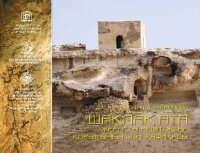The rock-cut mosque of Shaqpaq-Ata: a preliminary archaeological evaluation based on the publication of its inscriptions by A. Muminov and A. Nurmanova Peter Talloen PhD, Senior Research Fellow Research Center for Anatolian Civilizations Koç University

06 июня 2013
The rock-cut mosque of Shaqpaq-Ata: a preliminary archaeological evaluation based on the publication of its inscriptions by A. Muminov and A. Nurmanova
Peter Talloen
PhD, Senior Research Fellow
Research Center for Anatolian Civilizations
Koç University
The rock-cut mosque of Shaqpaq-Ata stands out among the rock-cut structures of Mangystau in western Kazakhstan, due to its complex plan and the vast necropolis that developed around the site. Yet, in spite of the research conducted at the site over the last three decades still many questions remain as to its origin and function.
The Latin-cross shape of the rock-cut structure and especially its eastern orientation seemingly suggest a Christian inspiration, or perhaps even a Christian (Nestorian) origin for this monument, which could place it in the 9th – 11th centuries, as suggested by Medoyev (1969), though he relates the structure to Seljuk architectural traditions rather than Christian ones; the mihrab present in the southern wall of the south arm would then belong to a later Muslim conversion of the building. However, similar cruciform plans for Muslim places of worship (masjid) are known to have developed in Iran during the Il-Khanid period in the 13th century, consisting of four iwan halls arranged on a cross plan around a central hall (see Bier 1986). This would correspond with the early 14th century date suggested Mengdiqulov (1987) on the basis of the archaeological excavations at the site. Although the execution of the Shaqpaq-Ata mosque is crude compared to the Iranian examples, with far less architectural decoration, the presence of raised floor levels in the arms of the cross, and the vertical shaft in the vault above the central square (allowing light and ventilation into the interior) are similar features in both traditions. Given the proximity of the Ilkhanate, which controlled part of the east shore of the Caspian Sea, adjacent to the Mangyshlak Peninsula, it may well have been the source of inspiration for the Shaqpaq-Ata mosque.
The numerous inscriptions recorded at the mosque and in the adjacent necropolis, which were published by A. Muminov and A. Nurmanova (2009), testify to the popularity of the shrine and identify it as a place of Muslim pilgrimage. Caves and grottos acquired sanctity in Islam through association with religious leaders or holy men who resided or were buried there (Bier 1986: 127). It is tempting to connect the rock-cut architecture of Shaqpaq-Ata with the commemoration of a holy individual. The annex space cut on the east side of the east arm may be a (later?) addition to the original cruciform plan, possibly to accommodate the tomb of a local saint, perhaps to be identified with the legendary figure of Shaqpaq-Ata after whom the mosque was named.
Further archaeological research of this exceptional monument and the surrounding cemetery is highly recommended as it would certainly enhance our general understanding of the site and provide more clear-cut answers as to the date, religious origin (Christian or Muslim), and function of the complex in a region that so far has been neglected by archaeological research.
Bibliography
Bier, L. (1986) The Masjid-I Sang near Darab and the Mosque of Shahr-I Ij: Rock-cut architecture of the Il-Khanid period, Iran 24, 117-130.
Medoyev, A.G. (1969) Podzemnaia arkhitektura kochevnikov poluostrova Mangyshlak, Prostor 6, pp. 51-57.
Mengdiqulov, M. M. (1987) Pamiatniki narodnogo zodchestva Zapadnogo Kazakhstana, Alma-Ata.
Muminov, A. and A. Nurmanova (2009) Shaqpaq-Ata: Inscriptions of the Underground Mosque and Necropolis, Almaty.
